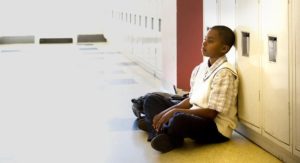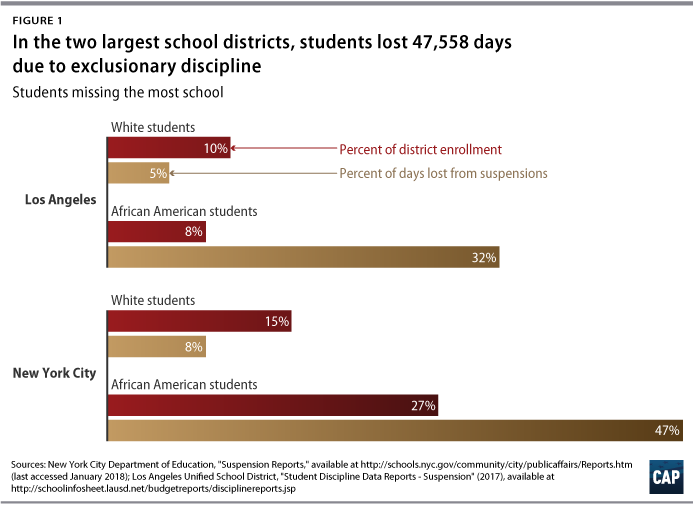“The undeniable truth is that the everyday education experiences for too many students of color violate the principle of equity at the heart of the American promise.”
former Secretary of Education Arne Duncan
J.J Powell, a preschool student, was labeled dangerous and destructive by teachers at the age of four and has been suspended from school five times for minor instances such as hitting a teacher on the arm. Unfortunately, JJ’s story is not unique, but rather part of a pattern of harsh disciplinary tactics in schools nationwide. A ten-year-old fifth-grade student climbed on top of a table in class and was handcuffed and pinned face down by police officers as a result. A fifteen-year-old eighth-grade student was arrested, handcuffed, and taken to a juvenile detention center for six days for throwing candy at another student on a school bus. Despite these instances of discipline occurring in public schools all throughout the United States, all of these students have one trait in common. They are all African American students.
Racial Disproportionality
African American students nationwide are being significantly punished for minor misbehavior that does not call for suspensions or harsh disciplinary tactics. Data shows that harsh disciplinary actions in itself has a direct connection to discriminatory acts on the basis of race in schools. For example, during the 2016-2017 academic school year, the two largest school districts in the United States suspended students for over 47,000 days.
In New York, African American students make up 27 percent of the population but account for nearly half of school days lost due to suspensions. In Los Angeles, African American students account for 8 percent of enrollment but nearly 40 percent of missed school days due to suspension. Hence, African American students are being suspended from school at substantially higher rates than white students.
Unparalleled Treatment
In addition to African American students being suspended more than white students across all grade levels, they are also subject to much harsher discipline than white students for similar types of misbehavior. According to a recent study, in fights involving a black student and a white student, the difference in punishment is statistically significant. Black students are given longer suspensions than white students involved in the same fight, specifically about one extra day out of school for every 20 incidents.This is a clear indication of how racial bias plays a substantial role not only in how students are disciplined differently in the school system but also how individual teachers and administrators make decisions that may be clouded by race.
School to Prison Pipeline
Even more disturbing, research shows that forms of harsh school discipline can lead African American students out of school and into prison. Students who are suspended, expelled, or heavily disciplined are more likely to drop out of school and enter the juvenile justice system. Correspondingly, African American students are already three times more likely to be suspended or expelled than white students and make up over 30% of arrests in schools due to harsh disciplinary tactics nationwide. Therefore, these findings have led researchers to conclude that African American students are 10x more likely than white students to end up in the prison system.
Policy Recommendations
Now that we know that African American students can greatly suffer from harsh disciplinary tactics in schools, educators and academic administrators should develop alternative ways to address student misconduct and recognize racial biases towards students of color through restorative practices and racial bias training.
Restorative Practices
Although there are many proposed ways to fix faults in school discipline, restorative justice practices can result in fewer unnecessary suspensions and expulsions and decrease the number of students entering the juvenile justice system. Restorative practices allow teachers and academic administrators to engage with students to resolve misconduct without using harsh discipline and prevent future misbehavior. For example, instead of arresting, expelling, or suspending students immediately for minor infractions, teachers should respond to students by asking, “What do you think the consequence should be? What made you do this? What can we do to help prevent this?” We see the positive effects of school discipline reform in Merced, California where three school districts implemented restorative practices for student misbehavior in 2014. As a result, these school districts in Merced reduced suspensions by 20% and lowered dropout rates, thus leading fewer students down the school to prison pipeline.
Racial Bias Training
At the classroom level, it becomes apparent that the severity of punishment for black students often has more to do with a teacher’s individual racial bias rather than overall student behavior. Many teachers have recognized this and believe that an anti-racial bias training would be very beneficial. According to a 2016 survey, 76 percent of teachers said that they wanted more training so that they would not contribute to racial disparities in discipline. Fortunately, several organizations have responded by implementing teacher training that combats racial disparities in discipline on an individual level. These racial bias trainings have been successful in leading teachers to become more effective in building positive classroom spaces where they can focus on restorative practices rather than discriminatory discipline on the basis of race.
Conclusion
I have seen the need for these policy recommendations first hand. When I was in grade school, I was subjected to harsher disciplinary actions than my white peers for violating similar school policies. However, I did not know that this was part of a bigger trend. Given the new data from the U.S. Department of Education, we see that my experience is like many other African American students nationwide. It is up to us as educators, students, parents, and members of the community to respond to these discriminatory patterns. We must advocate for racial bias training for teachers and more restorative practices for school discipline to secure the right of African American students having equal educational opportunities. Ultimately, schools should be a safe houses where all students feel secure and are not pushed out of the classroom because of the color of their skin.




